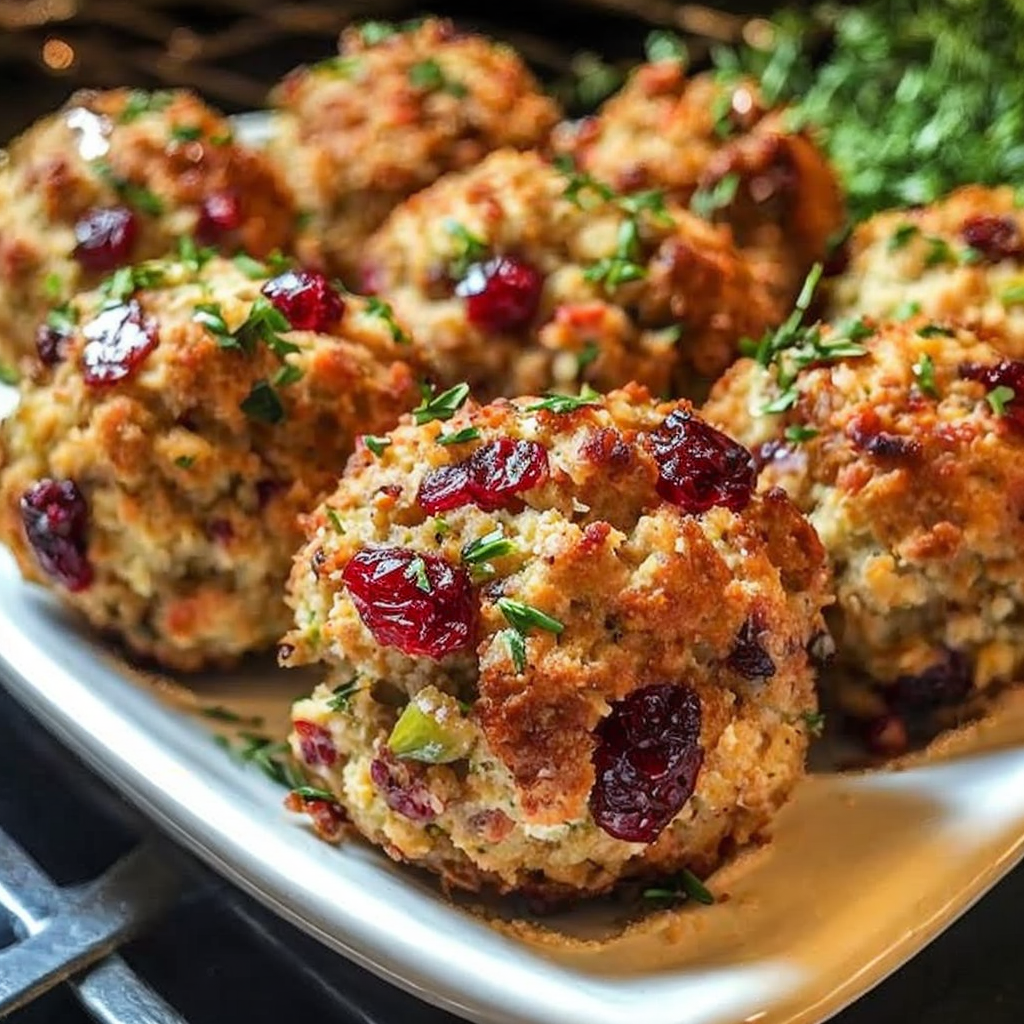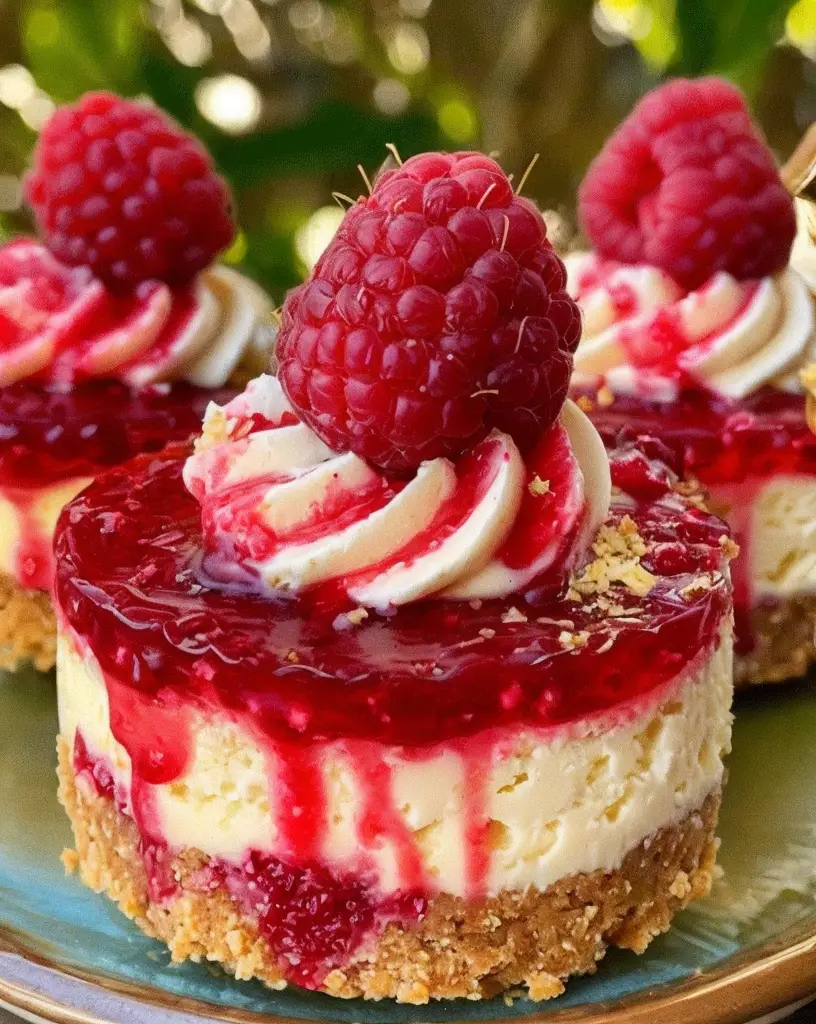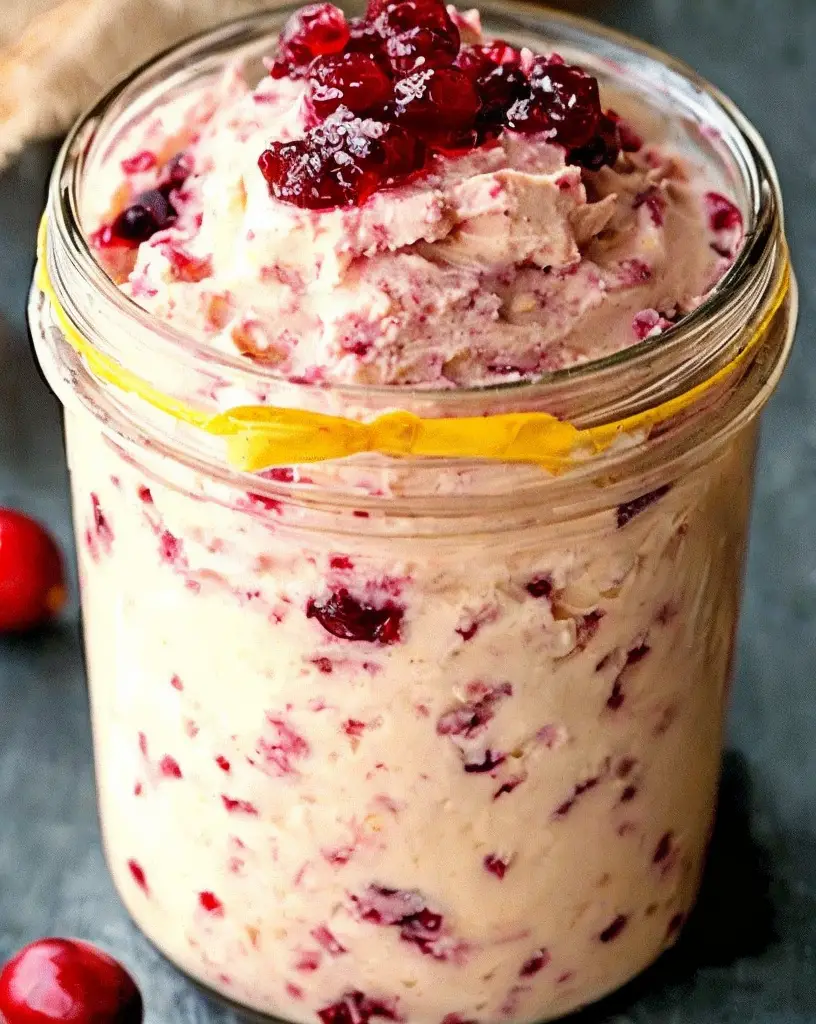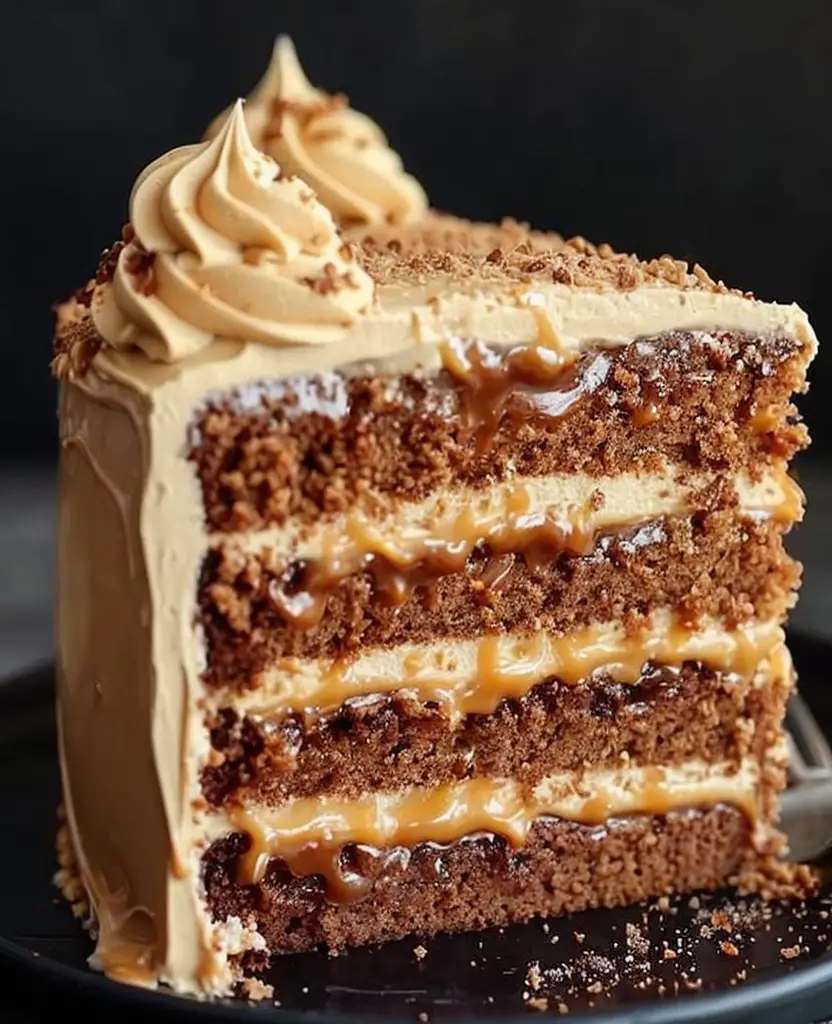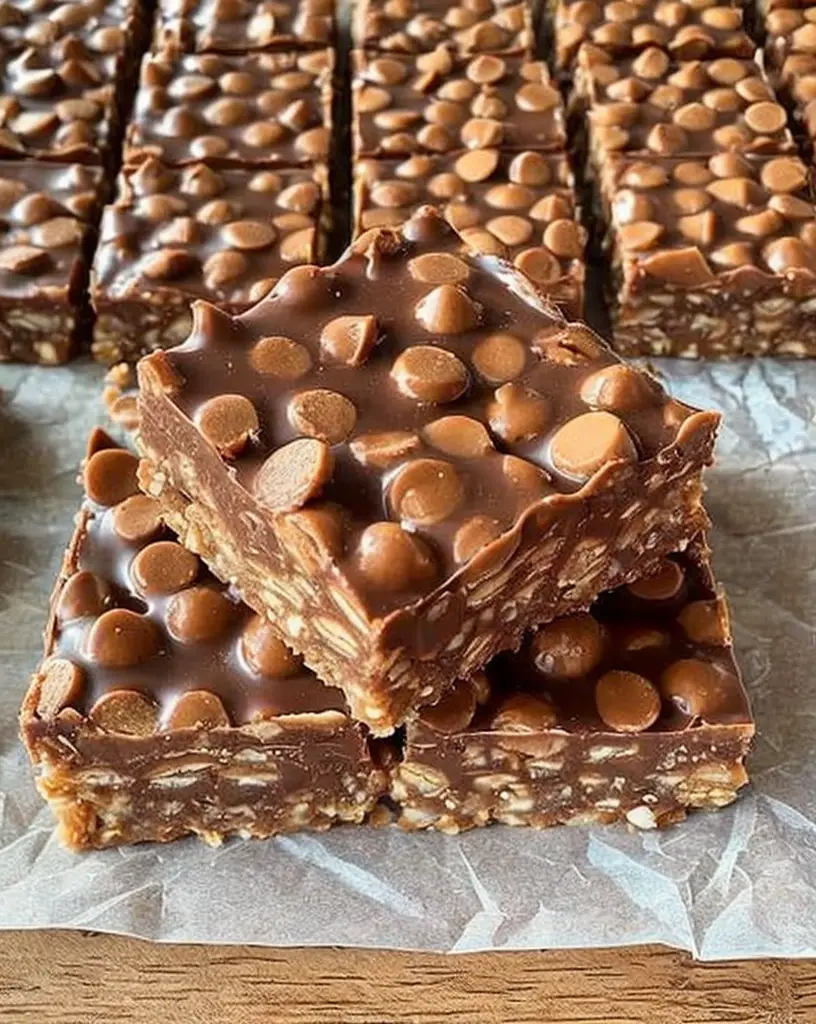Festive Cranberry Turkey Stuffing Balls: A Holiday Delight
Imagine celebrating the holidays with a dish that perfectly encapsulates the spirit of the season. Festive Cranberry Turkey Stuffing Balls combine all the traditional flavors of Thanksgiving into perfectly bite-sized portions. The savory essence of turkey mixed with the tart sweetness of cranberries and the warmth of classic stuffing spices create a harmony of flavors that’s truly irresistible. Whether you’re hosting a gathering or simply want to enjoy a taste of the holidays, these stuffing balls are a delicious and convenient solution.
These delectable Festive Cranberry Turkey Stuffing Balls are not just about taste—they bring visual appeal and an enticing aroma to your table as well. Picture crispy golden-brown exteriors giving way to moist, flavorful interiors. Each bite releases the comforting smell of herbs and cranberries, instantly evoking cherished memories around the dinner table. Moreover, they’re easy to prepare, making them the perfect addition to your holiday menu without the stress.
Quick Recipe Highlights
- Flavor Profile: A delightful blend of savory turkey and tart cranberries, complemented by fragrant herbs and spices.
- Texture: Crispy on the outside with a moist, tender interior that melds the best of stuffing and turkey in every bite.
- Aroma: Inviting scents of roasted turkey and herbs, with a hint of cranberry sweetness wafting through the kitchen.
- Visual Appeal: Perfectly golden in color, these stuffing balls add a charming and festive touch to your dining table.
- Skill Level Needed: Simple and straightforward, requiring basic mixing and baking skills.
- Special Equipment: Baking sheet, mixing bowl, and measuring cups for an effortless preparation.
Recipe Overview
- Difficulty Level: This recipe is easy to master, even for novice cooks. The steps are straightforward, making it a great choice for a first-time holiday cook.
- Category: Perfect as an appetizer or a side dish, these stuffing balls fit well into any festive spread.
- Cuisine: Rich in holiday tradition, they pull from classic American Thanksgiving elements with a contemporary twist.
- Cost: Economically satisfying, this dish uses common holiday ingredients that are budget-friendly.
- Season: Best enjoyed during the fall and winter holidays, they capture the essence of Thanksgiving and Christmas.
- Occasion: Ideal for large family gatherings, potlucks, and festive celebrations where convenience and taste are paramount.
Why You’ll Love This Recipe
These Festive Cranberry Turkey Stuffing Balls boast a flavor that is both nostalgic and comforting. The juxtaposition of tart cranberries with savory turkey and herbed stuffing creates a well-balanced taste that delights the palate. Each bite is a sensory celebration, making them a standout dish during holiday meals.
One of the major conveniences is their make-ahead potential. You can prepare these stuffing balls ahead of time, allowing you to focus on other elements of your holiday feast. Their bite-sized nature means that they also serve well as appetizers, reducing the need for multiple courses and thus simplifying your hosting duties.
On the nutrition front, these stuffing balls pack protein from turkey along with fiber from the bread and cranberries, offering a reasonably balanced addition to your holiday menu. They’re a more wholesome option compared to some traditional heavy dishes, allowing guests to indulge without overindulgence.
Socially, they serve as a fantastic talking point. Friends and family will love the idea of enjoying stuffing in a new form. They’re easy to serve and pass around, making them perfect for mingling during holiday parties. Plus, their festive appearance and aroma set the stage for contagious holiday cheer.
Cost-effectiveness is another highlight. Utilizing leftovers or affordable ingredients, these stuffing balls are a host’s dream, as they don’t break the budget. This accessibility means that you can whip up a batch for every event without overthinking the expense.
Historical Background and Cultural Significance
The tradition of stuffing can be traced back to ancient times where different cultures would stuff various meats and vegetables to enhance their flavors. In America, stuffing became synonymous with Thanksgiving, dating back to early colonial days when it was introduced using native ingredients like cornmeal and herbs.
Cranberries, another staple, have deep roots in North American cuisine, serving as both a food item and a medicinal ingredient for Native Americans. They were integral to indigenous diets and later became a Thanksgiving essential as settlers learned their nutritional benefits and tart flavor.
Over the years, stuffing recipes have evolved significantly, incorporating regional ingredients and international influences. What was once a simple mixture has now branched into diverse interpretations, including these easily shareable stuffing balls that offer portability and ease of serving during festive occasions.
Across different regions, similar recipes have emerged, with each adapting to local tastes and available produce. In the southern U.S., cornbread stuffing is popular, while the North often features herb-seasoned bread. Our recipe combines these traditional elements with modern practicality, providing a festive twist on a timeless classic.
Ingredient Deep Dive
Turkey, a central ingredient, is a low-fat protein source that has cemented its place as the go-to meat for festive occasions. Its history in holiday cooking is rich, known for its ability to complement diverse flavors such as the tang of cranberries.
Cranberries are esteemed not only for their bright color but also for their tangy, refreshing taste and health benefits, being a source of antioxidants and vitamins C and E. When selecting cranberries, look for those that are plump and firm, avoiding any that are shriveled or bruised.
For the bread, a quality loaf can make all the difference in your stuffing balls. Opt for something slightly stale, which will absorb flavors better and hold up during cooking. If purchasing in advance, store it in a dry area, ensuring it doesn’t become moldy or overly stale.
Common Mistakes to Avoid
- Using overly fresh bread, which may lead to soggy stuffing balls. Allow the bread to become slightly stale or toast it lightly before using.
- Overmixing the stuffing mixture can lead to a dense texture. Mix until just combined for the best results.
- Under-seasoning can make these stuffing balls bland. Taste the mixture before baking to ensure it’s well-seasoned.
- Overbaking results in dry stuffing balls. Keep an eye on them and remove from the oven once they’re golden brown.
- Not cooling the turkey leftovers could lead to a mushy texture. Allow them to cool slightly before mixing.
- Adding too many cranberries can dominate the flavor. Balance the ratios to maintain harmony in taste.
- Skipping the resting time after baking may cause your stuffing balls to fall apart. Letting them sit ensures they set properly.
- Forgetting to grease the baking sheet can lead to sticking. Ensure all surfaces are adequately prepared for a clean release.
Essential Techniques
The art of creating perfect Festive Cranberry Turkey Stuffing Balls lies in achieving the right stuffing consistency. It’s crucial to balance moisture levels to ensure the stuffing holds together without becoming too dry. Test the mixture by forming a small ball in your hand; it should hold its shape but remain slightly pliable.
Even cooking is vital, so space the stuffing balls uniformly on a baking tray. This helps maintain consistent heat distribution, ensuring each ball is perfectly cooked throughout.
The browning of the stuffing balls is your cue to their readiness. A golden crust will hint at the delicious contrast between a crisp exterior and a moist interior. Check from time to time to avoid overbaking, which may result in a less appetizing, overly crunchy texture.
Pro Tips for Perfect Festive Cranberry Turkey Stuffing Balls
Ensure your turkey leftovers are finely chopped for a cleaner mix with the bread and cranberries. Larger pieces might not bind well with other ingredients, affecting the overall texture.
Soak the bread pieces briefly in chicken stock before mixing. This step ensures a deeper flavor infusion throughout the stuffing balls.
Adjust the cranberry amount based on tartness preference. Fresh cranberries will offer a sharper taste than dried ones.
Add a dab of butter on top of each stuffing ball before baking to encourage an extra golden and flavorful crust.
Sprinkle a pinch of fresh herbs over the cooked balls immediately after removal from the oven. This enhances aroma and adds a vibrant green color.
Experiment with cheese by incorporating grated cheddar or parmesan into the mixture for added richness.
Utilize a mini muffin tin for consistent shapes and portions. This helps especially when serving at larger gatherings for uniformity.
Variations and Adaptations
Consider a Southern take by using cornbread instead of traditional white bread, adding a touch of sweetness to balance the tart cranberries.
For a winter variation, include finely chopped nuts like pecans or walnuts to introduce a crunchy element.
Replace turkey with chicken for a more economical option without losing traditional flavors.
To easily make this dish vegetarian, substitute turkey with sautéed mushrooms, bringing a hearty, umami flavor to the stuffing.
Incorporate seasonal vegetables like diced roasted pumpkin for a fall twist, adding both color and a subtle sweetness.
Get creative with presentation by using festive cocktail sticks, allowing guests to easily partake at celebratory events.
Serving and Presentation Guide
Arrange these stuffing balls around a central serving dish of cranberry sauce for a beautiful and cohesive presentation. The glistening red of the sauce against the golden balls creates an enticing contrast.
Sprinkle fresh chopped parsley over the balls before serving to add a splash of vibrant color and a fresh aroma.
Traditional accompaniments like gravy or herb-infused olive oil complement these balls well, enhancing their rich flavors.
For a modern look, consider serving the stuffing balls in individual ramekins, elevating the presentation and making them perfect for personal-sized servings.
Ensure they are served warm, as the texture and flavors are best experienced when freshly baked.
Portion control is simplified with these stuffing balls, making them ideal for buffets, where guests can easily choose how many they’d like to enjoy.
Wine and Beverage Pairing
A bright, fruity Pinot Noir pairs exceptionally well with these Festive Cranberry Turkey Stuffing Balls, highlighting the cranberry while balancing the turkey’s flavors.
Consider a crisp white like a Chardonnay, which offers a buttery note that complements the dish’s savory aspects perfectly.
Non-alcoholic options like a sparkling cranberry lemonade can mirror the cranberries used in the recipe, tying the flavors together.
If serving coffee or tea, opt for a light-bodied black tea that provides a subtle contrast to the stuffing’s richness.
For best results, serve both wines and beverages slightly chilled, enhancing the festive atmosphere.
Wine should be poured just before the meal to ensure it maintains optimal temperature and flavor profile throughout the course.
Storage and Shelf Life
Store any leftover stuffing balls in an airtight container in the refrigerator, maintaining their freshness for up to three days.
For extended storage, these stuffing balls freeze well. Place them on a baking sheet to freeze initially, preventing them from clumping together, then transfer to a freezer bag.
Reheat frozen stuffing balls in the oven to regain their crispy exterior. Let them thaw slightly and bake at a moderate temperature.
Signs of spoilage include a noticeable change in texture or an off smell, at which point leftovers should be discarded.
Use airtight containers to prevent exposure to air, which can cause the stuffing balls to dry out.
Avoid microwaving unless absolutely necessary, as this can lead to uneven reheating and loss of crispness.
Make Ahead Strategies
Prepare the stuffing mixture a day in advance, storing it covered in the refrigerator. This allows the flavors to meld together, enhancing taste.
Form the stuffing balls the night before and place them on a baking sheet. Cover and refrigerate, enabling you to bake them fresh just before serving.
Reheat cooked stuffing balls in a preheated oven, rather than a microwave, to maintain their delightful crispy texture.
Consider splitting the prep work—one day for mixing and another for forming and baking to manage time efficiently.
Ensure thawing time if pre-baking and freezing, moving them to the fridge a day ahead to thaw gently.
Add fresh garnishes like herbs or cranberry sauce just before serving to maintain their vibrancy and freshness.
Scaling Instructions
Easily halve the recipe for smaller gatherings without affecting the final outcome, adjusting the ingredient quantities accordingly.
Doubling or tripling the recipe is straightforward, though ensure you have adequate baking sheets and oven space to accommodate larger batches.
When increasing quantities, distribute the mixture evenly across multiple baking sheets to avoid overcrowding in the oven.
Adjust cooking times slightly if necessary, checking for doneness to prevent over-baking when producing larger batches.
Storage considerations are crucial when scaling. Ensure enough space for refrigerated or frozen leftovers.
Large-scale production might require additional mixing bowls or utensils to comfortably blend ingredients without spillage.
Nutritional Deep Dive
These stuffing balls offer a balanced macronutrient profile with protein from turkey, carbohydrates from bread, and a modest amount of healthy fats.
Cranberries supplement with vitamin C and antioxidants, contributing to the dish’s nutritional value.
Herbs like sage and thyme provide flavor without adding calories, making these balls a wholesome choice within a varied diet.
Portion control ensures that you’re serving a reasonable amount of calories while still enjoying the satisfying flavors of your holiday meal.
Pay attention to sodium levels in ingredients like stock or pre-seasoned bread to maintain heart health.
Weight management can be supported by opting for whole grain bread and leaner turkey meat, adding fiber and reducing fat.
Dietary Adaptations
Create a gluten-free variation by substituting traditional bread with gluten-free alternatives like cornbread or gluten-free rolls.
For a dairy-free version, ensure any stocked used is free from added dairy ingredients.
Take a vegan approach by replacing turkey with a combination of roasted mushrooms and walnuts, offering a savory umami effect.
A low-carb option involves using almond flour or a similar low-carb mix as a binding agent instead of breadcrumbs.
Keto-friendly adaptions would use almond flour and increase the fat content slightly with added butter or cheese for a richer taste.
Paleo adaptations replace bread with a mixture of almond meal or coconut flour and additional nuts for texture.
For a Low-FODMAP version, avoid ingredients like garlic or onion and use substitutes such as garlic-infused oil for flavoring.
Troubleshooting Guide
If your stuffing balls appear too dense, consider loosening the mixture with additional liquid like stock, ensuring a softer finish.
Balance the flavor by adjusting seasoning if the initial taste falls flat; sometimes a touch more salt or herbs can elevate the dish drastically.
Ensure oven temperatures are correct if browning is uneven or inconsistent, checking with an accurate oven thermometer.
In case of ingredient substitutions, verify equivalencies to maintain recipe integrity, as some alternatives may alter texture or flavor unexpectedly.
Adjust cooking times based on your specific equipment and environment; not all ovens heat evenly, and altitude can affect cooking times too.
Monitor moisture levels if the mixture seems too dry or wet, as ingredient variations often necessitate a bit of flexibility in preparation.
Recipe Success Stories
Readers have shared numerous adaptations of these stuffing balls, incorporating local flavors and adding personal twists, like adding a touch of bacon or roasted peppers.
One variation featured the addition of dried apricots, praised for adding a unique sweetness that complemented the cranberries beautifully.
Engaging photos captured by our community showcase creative plating methods, from elegant starters to cozy holiday meals, inspiring others to try this delightful recipe.
Several fans have found success using these stuffing balls as sandwich fillers the next day, proving their versatility and appeal.
Enthusiastic cooklings have noted how popular these balls have become at potlucks, with requests for the recipe often following soon after.
Frequently Asked Questions
Yes, you can prepare the mixture ahead of time and freeze the unbaked balls. Bake them as needed to keep them fresh and crispy.
What type of bread works best?
Slightly stale bread is ideal as it absorbs flavors better. White or sourdough works well, but you can also experiment with different types like rye or whole grain.
How do I prevent the balls from falling apart?
Ensure the mixture is moist enough to bind by checking that the breadcrumbs are sufficiently soaked in broth and that the turkey is chopped finely.
Can I use fresh cranberries?
Fresh cranberries provide a more tart profile and can be used in moderation. Adjust sugar or sweetening agents to balance their natural tartness.
What should I do if the stuffing is too dry?
Gradually add more broth to the mixture until it reaches a sticky consistency that holds its shape when formed into balls.
Are there any vegetable substitutions available?
Certainly. Swapping in ingredients like diced bell peppers or shredded carrots can add variety and boost nutritional content.
What is the best way to reheat these stuffing balls?
The oven is the best method to reheat, restoring crispiness while ensuring even warming throughout. Avoid microwaving for best results.
How can I make these balls spicier?
Add a pinch of cayenne pepper or chili flakes to the mixture to introduce a slight heat that complements the other flavors.
What are nutritious accompaniments?
Pair them with a crisp salad or roasted vegetables, bringing balance and freshness to the meal.
Do these stuffing balls freeze well?
Yes, they freeze beautifully and can be baked from frozen, making them a convenient make-ahead option for busy holiday times.
Additional Resources
For a deeper exploration of stuffing variations, consider looking into regional stuffing recipes like those featuring cornbread or wild rice, each bringing unique traits to the table.
Several technique guides available online can help with perfecting the art of making stuffing, offering tips on seasoning and texture management.
Ingredient-specific literature delves into the benefits of cranberries and turkey, clarifying why these staples hold such value in festive dishes.
Equipment recommendations can guide you to the best tools for baking these stuffing balls, from non-stick trays to silicone mats that ensure easy cleanup.
Seasonal twists can include changes based on the availability of fresh herbs or seasonal fruits, providing a new angle for traditional recipes.
Join the Conversation
We love seeing your interpretations of Festive Cranberry Turkey Stuffing Balls. Share your creations on social media using #FestiveStuffingBalls for a chance to be featured in our roundup.
For aspiring food photographers, experiment with different lighting and angles to capture the vibrant colors and textures of your dish.
Leave reviews on the recipe page to let others know about your experiences, and discuss how you tailored the recipe to suit dietary needs or preferences.
Engage with our community by exchanging tips and variations. Your insights might just help someone create their perfect holiday menu.
Keep experimenting with ingredient combinations, and don’t hesitate to revisit and tweak the recipe based on feedback and your evolving culinary skills.
The Recipe
Festive Cranberry Turkey Stuffing Balls
Serves: 6
Prep Time: 15 mins
Cook Time: 30 mins
Total Time: 45 mins
Kitchen Equipment Needed
- Baking sheet
- Mixing bowl
- Measuring cups
- Mixing spoon
- Chopping board and knife
Ingredients
- 2 cups leftover turkey, finely chopped
- 1.5 cups cubed bread, slightly stale
- 1/2 cup dried cranberries
- 1/3 cup chopped celery
- 1/4 cup finely chopped onion
- 1 tsp dried sage
- 1 tsp dried thyme
- 1/2 cup chicken or turkey broth
- Salt and pepper to taste
- 2 tbsp melted butter
Directions
- Preheat oven to 375°F (190°C) and lightly grease a baking sheet.
- In a mixing bowl, combine the turkey, bread cubes, cranberries, celery, onion, sage, and thyme.
- Slowly add the broth while mixing until the mixture holds together.
- Season with salt and pepper according to taste.
- Shape the mixture into balls and place them on the prepared baking sheet.
- Brush the tops with melted butter for a golden finish.
- Bake for 25-30 minutes or until the balls are firm and golden brown.
- Let them rest for a few minutes before serving with your choice of dipping sauces or as part of a festive meal.
Recipe Notes
- Consider using lemon zest in the mixture for an added citrusy freshness.
- Swap dried cranberries with cherries for a different fruit profile.
- Leftovers can be crumbled and used as a topping for casseroles or salads.
